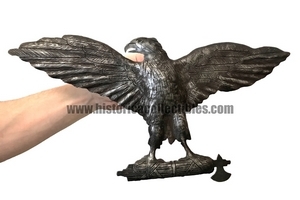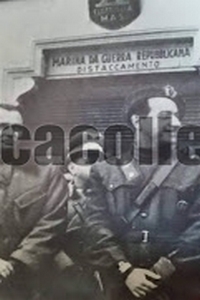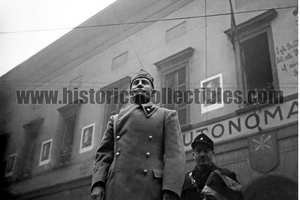R.S.I. Italian Social Republic, Republican Eagle, F.lli Lorioli Milano, 1944
Republican Eagle in iron, die-minted and burin-finished, made by the "Fratelli Lorioli Milano" company in 1944.
Archetypal sculpture of a Republican Eagle in iron, die-minted, with a rounded shape and subsequently finished with a hammer and burin through which rectifications, improvements, refinements and finishing of its profiles, legs, wings and feathers were manually applied, giving an adequate and appropriate three-dimensionality to the image, probably with the intention of subsequently creating the minting for the mold in its definitive form.
This sculpture was created in the first period of the Italian Social Republic, by the Stabilimento Artistico F.M. Lorioli brothers of Milan. As reported on the three labels, located on the back of it, the production characteristics of this unique artefact are highlighted, also stamped "FLM", (Fratelli Lorioli Milano) on the iron.
In fact, on the largest label headed "Stabilimento Artistico F.M. Lorioli Fratelli" (in relief) you can read the data regarding the model number, the subject, and the number of the mint used for its creation, as well as an internal reference number, also it in relief, the establishment and the date which probably lead it back to the month of February 1944; furthermore, the other two labels show its dimensions, the engraver's serial number and the tool used for the "finishing" engraving.
We learn that this example is the archetype of what probably was (or should have been) a series of Republican Eagles which are/would have been hung in barracks, offices etc etc., a bracket drilled and welded to the back , confirms this use.
What is certain, however, is that this sculpture shows the identical characteristics of the design of the Republican Eagle printed in the center of the tricolor flag, which belonged to the Italian Social Republic in the period 1944/1945, therefore the fact that the design on it was chosen cannot be excluded precisely from this model archetype.
F.LLI LORIOLI ARTISTIC ESTABLISHMENT MILAN
"FLM". These three letters, in the form of an acronym, practically characterized, until almost the mid-1950s, the production of medals at the Lorioli factory, founded in 1919 by the joint work of two brothers: Filippo, a steel engraver, and Michele, a goldsmith. The first workshop was based in Milan, in via Anzani, but the rapid expansion of production made it necessary to transfer the business to a more suitable structure in 1924, in via Bronzetti 25, also in Milan. The Second World War led to a slowdown in production activity which was reduced in August 1943, when the factory was seriously damaged by bombing. The post-war period entailed a reorganization of the business and the construction of a new and broader sales network. This was a particularly delicate period for reasons both internal and external to the company: in 1946 Edgardo Lorioli died prematurely shortly after his cousin Gualtiero withdrew from his commitment to the company; processing methods and concepts change; the market situation changes. The leadership is assumed by Arturo Lorioli, who avails himself of the collaboration of Franco Savoia for the commercial sector and Giovanni Amati for the administrative one.
In the early fifties, Vittorio Lorioli, son of Edgardo, Filippo and Giampaolo, descendants of Arturo, became part of the company management. Lorioli transforms from a partnership to a joint-stock company, consolidating its position through the acquisition of an office in Rome, agencies in the main Italian cities and some representations abroad. Since the expansion and rationalization of the production departments was necessary, construction of the new factory in Cernusco sul Naviglio began in 1959 and was inaugurated the following year. Upon the death of Arturo Lorioli in 1965, the third Lorioli generation was professionally and logistically able to continue the family business. The production of traditional processes is enhanced and specialized sectors are launched, such as that of art multiples, intensifying collaboration with artists and relationships with collectors. Lorioli participates in the main national and international medal events and exhibitions. Indicative is the award in 1983 of the AIAM (Italian Medal Association) award, an association that brings together artists, publishers and medal enthusiasts. In 1990 the members of the Lorioli family sold the company and the production of the plant was diversified. Work in the medal sector ceased in 1994. Vittorio Lorioli remained in the sector as a consultant and researcher, making an important contribution to medal studies. He collaborates, among other things, with the specialized magazine "Cronaca Numismatica". In 1996 he increased the medal collection of the Historical Museum of Bergamo with a thousand medals of historical interest from 1919 onwards. In 1995 he deposited 150 medals made by the family company at the Accademia Carrara in Bergamo which, together with the concomitant donation from Cesare Johnson, build the initial nucleus of the GAMEC Collection of Contemporary Medals. In 2005 he enriched the Lorioli donation with over one hundred models and bronzes.
The Lorioli mold heritage had reached a notable size over time: more than 40,000 molds for medals and over 20,000 for badges, plaques and similar objects, as well as models, cutting irons and various tools relating to them.
This material was carefully preserved, divided into sectors and numbered progressively; once production has ceased, it is now mostly no longer available or traceable. The factory, renowned on the national and international market, over time and up to the beginning of the nineties, saw involved in the management of the company, after the founders, the their children and their children's children. Since 1960 the production activity had been transferred to a new complex in Cernusco sul Naviglio, on the outskirts of Milan.




